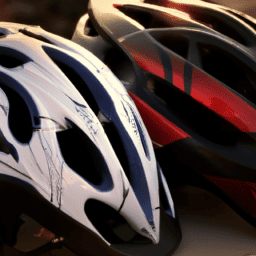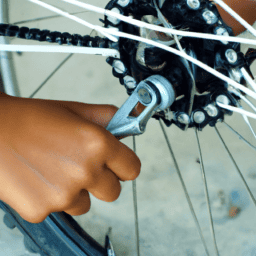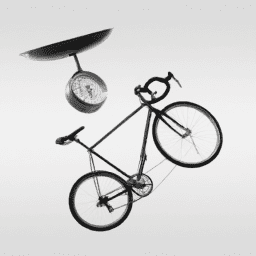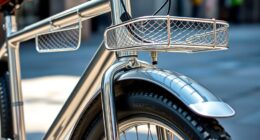As someone who bikes, I understand how crucial it is to wear the right helmet while cycling. It offers protection for my head against possible injuries and also provides me with a sense of security throughout my cycling sessions.
However, do you know when it’s time to replace your helmet? It’s important to know the signs of wear and tear, as a properly functioning helmet is crucial for your safety on the road.
There are several factors that affect the lifespan of a helmet, including the frequency of use and the conditions you ride in. It’s essential to be aware of these factors and to regularly inspect your helmet to ensure it’s still providing adequate protection.
In this article, we’ll discuss the signs that it’s time to replace your helmet, as well as tips for choosing and maintaining your helmet. So, let’s dive into the world of helmet safety and make sure we’re all properly protected on our rides.
Key Takeaways
- A properly functioning helmet is crucial for safety while cycling, and the foam liner is the most important part for impact protection.
- Regular maintenance and inspection of the helmet, as well as proper storage away from direct sunlight, can help prolong its lifespan.
- Signs that indicate it’s time to replace a helmet include visible cracks or dents, age of the helmet, and worn or frayed straps or padding.
- Proper fit is crucial for safety, and adjustments to the chin strap, side straps, rear cradle, and padding may be necessary for a comfortable and safe fit.
The Importance of a Properly Functioning Helmet
You gotta make sure your helmet is working right, cuz it’s crucial for your safety when you’re on your bike. Proper helmet functioning is essential to ensure that your head is protected in the event of an accident. The helmet acts as a shock absorber and disperses the force of impact, reducing the risk of serious head injury.
To ensure proper helmet functioning, there are a few safety precautions you should take. Firstly, make sure that the helmet fits properly and is adjusted to the correct size, snugly fitting around your head.
Secondly, check that the helmet has no cracks or damage, as this can weaken the structure and reduce its ability to protect you.
Lastly, make sure that the helmet meets safety standards set by organizations such as the Consumer Product Safety Commission (CPSC) or Snell Memorial Foundation.
Ensuring that your helmet is functioning properly is crucial for your safety while cycling. However, there are several factors that affect the lifespan of a helmet, which we will discuss in the subsequent section.
Factors That Affect the Lifespan of a Helmet
As a cyclist, I know the importance of having a properly functioning helmet. However, it’s crucial to understand that helmets have a lifespan and need to be replaced when they are no longer effective.
There are several factors that affect the lifespan of a helmet, including age and wear and tear, impact damage, and exposure to sun and heat.
It’s essential to be aware of these factors to ensure that your helmet is always providing you with the necessary protection while you ride.
Age and Wear and Tear
Over time, helmets experience wear and tear, so it’s wise to replace an aging one. The age of a helmet can be determined by how often it’s used and how well it’s stored.
Helmets that are used frequently and not stored properly can break down faster than helmets that are used less often and stored in a cool, dry place. It’s important to check the helmet for any visible signs of wear and tear, such as cracks or dents, and to check the helmet ventilation system to ensure that it’s still working properly.
If the helmet is no longer in good condition, it’s time to replace it. Replacing an old helmet is especially important because it can reduce the risk of injury from impact damage. Helmets are designed to absorb the shock of an impact, but over time the foam inside the helmet can become compressed and less effective.
This means that an older helmet may not provide the same level of protection as a new one. It’s important to replace a helmet if it’s been involved in a crash, even if it appears to be in good condition. Impact damage may not be visible to the naked eye, so it’s better to err on the side of caution and replace the helmet.
Impact Damage
Hey there, did you know that impact damage can seriously compromise the effectiveness of your helmet? As a cyclist, it’s important to understand that helmets are designed to provide impact protection, but they can only do so much.
Even a minor impact can cause damage to the helmet materials, which can weaken the helmet’s ability to protect you in the event of a more significant impact. Any impact to your helmet, regardless of how minor it may seem, can cause damage to the materials inside.
The foam liner is the most important part of the helmet when it comes to impact protection. If this is damaged, the helmet may not be able to effectively absorb the force of an impact. Even if there are no visible signs of damage to the helmet, it’s a good idea to replace it after any impact to ensure that it will continue to provide adequate protection.
It’s important to follow the manufacturer’s guidelines for helmet replacement, which may recommend replacement after any impact or after a certain period of time. Regularly inspecting your helmet for signs of damage or wear and tear can help you identify potential issues and replace the helmet before it becomes compromised.
Understanding the impact damage that can occur to your helmet is just one part of keeping yourself safe while cycling. Another important consideration is exposure to sun and heat, which can also affect the effectiveness of your helmet.
Exposure to Sun and Heat
Don’t forget that when you’re out cycling, exposure to the sun and heat can also impact the effectiveness of your helmet. Sun damage and heat exposure can cause the foam inside your helmet to deteriorate faster, making it less effective in protecting your head in the event of an impact. It’s important to take care of your helmet to ensure that it lasts as long as possible and provides the maximum amount of protection.
To give you an idea of how much sun and heat exposure can affect your helmet’s lifespan, here’s a table that shows how quickly different types of foam can deteriorate based on exposure to sunlight and heat:
| No Exposure | Occasional Exposure | Frequent Exposure | |
|---|---|---|---|
| EPS | 5-10 years | 3-5 years | 2-3 years |
| EPP | 10-15 years | 5-7 years | 3-4 years |
| EPU | 15+ years | 7-10 years | 4-5 years |
As you can see, frequent exposure to the sun and heat can significantly reduce the lifespan of your helmet’s foam, meaning it may need to be replaced sooner than you think. In the next section, we’ll explore the types of riding and conditions that can also affect the lifespan of your helmet.
Types of Riding and Conditions That Affect Helmet Lifespan
If you frequently commute in heavy traffic or ride in extreme weather conditions, you should consider replacing your helmet more frequently, as these factors can decrease its lifespan.
Different riding styles and environmental factors also play a role in how long your helmet will last. For example, if you frequently ride off-road or participate in BMX competitions, your helmet may experience more impacts than if you primarily ride on smooth pavement. Similarly, if you often ride in hot and humid conditions, the sweat and heat can break down the materials in your helmet faster.
It’s important to also consider the age of your helmet, as even if you don’t ride frequently or in extreme conditions, helmets have a limited lifespan. Most manufacturers recommend replacing your helmet every 3-5 years, regardless of its condition or how often you use it.
Taking all of these factors into account will help you determine when it’s time to replace your helmet and ensure that you’re riding with adequate protection. In the next section, we’ll discuss some specific signs that it may be time to replace your helmet.
Signs That It’s Time to Replace Your Helmet
It’s crucial to prioritize your safety while cycling, and one telltale sign that it’s time to invest in a new protective headgear is when you notice visible cracks or dents on your current one. Even if the helmet hasn’t been involved in any accidents, these visible signs indicate that the structural integrity of the helmet has been compromised and may not provide adequate protection in the event of a crash.
Additionally, helmets have a lifespan of about 3-5 years, depending on usage and exposure to sunlight and extreme temperatures. It’s important to replace your helmet within this timeframe even if there are no visible signs of damage.
When replacing your helmet, it’s important to ensure that it meets current safety standards. Look for helmets that are certified by organizations such as the Consumer Product Safety Commission (CPSC) or the European Union’s CE En1078 standard. These certifications indicate that the helmet has undergone rigorous testing to ensure that it provides adequate protection in the event of a crash.
Additionally, be sure to choose a helmet that fits properly and is comfortable to wear. It’s also important to maintain your helmet properly by storing it in a cool, dry place and avoiding exposure to extreme temperatures or chemicals. With proper care and maintenance, your helmet can provide reliable protection for years to come.
Tips for Choosing and Maintaining Your Helmet
When it comes to choosing a helmet, finding the right fit is crucial for safety. A properly fitting helmet should sit level on your head, with the strap snugly secured under your chin.
It’s also important to regularly maintain and inspect your helmet for damage, such as cracks or dents. And remember, investing in a new helmet is always worth it when it comes to protecting your head while biking.
Finding the Right Fit
Ensuring the perfect fit for your bicycle helmet is crucial in protecting your head during a potential accident, so don’t hesitate to try on multiple options until you find the one that feels just right. The sizing accuracy of your helmet can make all the difference in an emergency situation. It’s important to measure the circumference of your head and consult the manufacturer’s sizing chart to ensure you’re getting the correct size. But keep in mind that sizing can vary between brands, so it’s recommended to try on helmets before purchasing.
Once you have the correct size, you’ll need to make helmet adjustments to ensure a secure fit. The table below outlines the proper adjustments to make for a comfortable and safe fit. Remember, a helmet that is too loose could easily come off during an accident, while a helmet that is too tight could cause headaches and discomfort. Finding the perfect fit may require some tweaking, but taking the time to do so could save your life in the event of an accident. With a properly fitted helmet, you’ll be ready to ride safely and confidently. In the next section, we’ll discuss the proper care and maintenance of your helmet to ensure it lasts as long as possible.
| Adjustment | How to Adjust | What to Look For |
|---|---|---|
| Chin Strap | Tighten or loosen the strap until it’s snug under your chin | Make sure the strap is centered and not twisted |
| Side Straps | Adjust the sliders until the straps form a V-shape under your ears | Make sure the straps are snug but not too tight |
| Rear Cradle | Adjust the dial until the helmet feels snug on your head | Make sure the helmet doesn’t move around on your head |
| Front and Rear Position | Adjust the helmet so it sits level on your head, with the front just above your eyebrows | Make sure the helmet doesn’t obstruct your vision |
| Padding | Add or remove padding to make the helmet fit comfortably | Make sure there are no gaps between your head and the helmet |
Proper Care and Maintenance
Now that we know how to find the right fit for our bicycle helmets, it’s important to understand how to properly care for and maintain them. After all, our helmets are designed to protect our heads, and we want to make sure they’re always in top condition. Here are some tips:
-
Cleaning methods: It’s important to clean your helmet regularly to prevent bacteria buildup and ensure that the helmet is functioning properly. Use mild soap and water to gently clean the helmet, and avoid using any harsh chemicals or abrasive materials that may damage the helmet’s integrity.
-
Storage solutions: When you’re not using your helmet, store it in a cool, dry place away from direct sunlight. Avoid storing the helmet in a hot car or in a place where it may be exposed to extreme temperatures, as this can weaken the helmet’s structure over time.
-
Frequency of maintenance: Check your helmet regularly for signs of wear and tear, and replace any damaged parts as needed. It’s also a good idea to replace your helmet every 3-5 years, even if it appears to be in good condition.
By following these proper care and maintenance tips, you’ll ensure that your helmet is always in top condition and functioning properly. However, even with proper maintenance, there may come a time when it’s necessary to invest in a new helmet. Let’s take a look at when it’s time to replace your helmet.
When to Invest in a New Helmet
It’s crucial to keep our heads safe while cycling, and as the saying goes, ‘better safe than sorry’, so knowing when to upgrade our headgear is essential. While helmets are designed to last for several years, it’s important to keep an eye out for signs that it’s time to invest in a new one. Upgrading features and helmet design innovations can provide better protection and comfort, making it worth the investment.
To know when to replace our helmet, we need to consider a few factors. The table below summarizes the signs that indicate it’s time to upgrade our headgear, including the recommended timeline for replacing it. It’s important to note that even if our helmet hasn’t been involved in an accident, it can still lose its effectiveness over time due to exposure to sunlight, sweat, and other factors. By staying aware of these signs and investing in a new helmet when necessary, we can ensure we’re always properly protected.
| Signs it’s time to replace your helmet | Timeline for replacing |
|---|---|
| Visible damage to the shell, such as cracks or dents | Immediately |
| The helmet no longer fits properly | Every 2-3 years |
| The padding is worn or compressed | Every 2-3 years |
| The straps are worn or frayed | Every 2-3 years |
| The helmet is over 5 years old | Every 5 years |
Frequently Asked Questions
Are there any regulations or laws regarding when to replace a bicycle helmet?
Helmet safety standards dictate the lifespan of a bicycle helmet, typically 3-5 years from the date of purchase. Proper maintenance, such as avoiding impact and storing in a cool, dry place, can extend its life.
Can a helmet be repaired or does it need to be completely replaced once it reaches its lifespan?
When a helmet reaches the end of its lifespan, it must be replaced. Repairs may compromise its safety. To prolong the life of your helmet, keep it away from heat and sunlight, and avoid dropping it.
How do I properly dispose of an old helmet?
To dispose of an old helmet, I can check with my local recycling options or donate it to a biking organization. Proper disposal is important to minimize the environmental impact of the materials used in the helmet.
Is it necessary to replace a helmet after a crash, even if it appears to be undamaged?
After a crash, helmet damage may not be visible, but safety concerns remain. A cost-benefit analysis should be done when deciding on helmet replacement. Safety is key, so replace if in doubt.
What is the difference between a cheaper helmet and a more expensive one in terms of lifespan and effectiveness?
When considering helmet lifespan and cost effectiveness, it’s important to understand that more expensive helmets often include advanced features that increase safety and durability. Cheaper helmets may need to be replaced more frequently to maintain effectiveness.
Conclusion
In conclusion, I can’t stress enough the importance of a properly functioning helmet. As a cyclist and safety advocate, it’s crucial to understand the factors that affect the lifespan of a helmet, such as the types of riding and conditions it’s exposed to. It’s also important to be aware of the signs that it’s time to replace your helmet.
Did you know that helmets are estimated to be 37% effective in preventing fatal injuries to cyclists, according to a study conducted by the Insurance Institute for Highway Safety? This statistic alone highlights the crucial role that helmets play in keeping cyclists safe on the road. Investing in a high-quality helmet and regularly checking for signs of wear and tear can make all the difference in preventing serious injury or even death in the event of an accident.
Remember, safety should always be a top priority when cycling. Don’t take any chances with your helmet – replace it when necessary and always wear it when riding. Happy and safe cycling!









